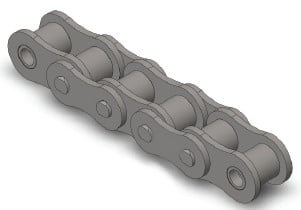The following ways need to be used to pick chain and sprocket sizes, ascertain the minimum center distance, and determine the length of chain needed in pitches. We are going to generally use Imperial units (such as horsepower) in this section having said that Kilowatt Capacity tables are available for every chain size while in the preceding area. The variety process is definitely the exact same irrespective with the units made use of.
Step one: Establish the Class with the Driven Load
Estimate which from the  following ideal characterizes the ailment with the drive.
following ideal characterizes the ailment with the drive.
Uniform: Smooth operation. Minor or no shock loading. Soft begin up. Moderate: Typical or moderate shock loading.
Heavy: Severe shock loading. Frequent starts and stops.
Phase 2: Determine the Service Aspect
From Table 1 below ascertain the appropriate Support Issue (SF) for your drive.
Step three: Calculate Style Energy Necessity
Design Horsepower (DHP) = HP x SF (Imperial Units)
or
Design and style Kilowatt Power (DKW) = KW x SF (Metric Units)
The Style and design Energy Necessity is equal to your motor (or engine) output energy times the Services Factor obtained from Table 1.
Phase 4: Create a Tentative Chain Choice
Create a tentative collection of the required chain size during the following method:
one. If applying Kilowatt power – fi rst convert to horsepower for this stage by multiplying the motor Kilowatt rating by one.340 . . . This is certainly vital since the fast selector chart is proven in horsepower.
two. Locate the Design and style Horsepower calculated in phase three by reading up the single, double, triple or quad chain columns. Draw a horizontal line as a result of this worth.
three. Locate the rpm with the smaller sprocket to the horizontal axis from the chart. Draw a vertical line by means of this worth.
4. The intersection in the two lines ought to indicate the tentative chain variety.
Phase five: Pick the number of Teeth for your Little Sprocket
The moment a tentative collection of the chain dimension is made we have to establish the minimal amount of teeth essential to the little sprocket needed to transmit the Layout Horsepower (DHP) or even the Design Kilowatt Electrical power (DKW).
Step six: Figure out the amount of Teeth for the Massive Sprocket
Utilize the following to determine the quantity of teeth to the large sprocket:
N = (r / R) x n
The quantity of teeth over the large sprocket equals the rpm of the little sprocket (r) divided from the sought after rpm of the large sprocket (R) times the quantity of teeth about the small sprocket. When the sprocket is also significant for your area accessible then various strand chains of the smaller sized pitch really should be checked.
Phase seven: Ascertain the Minimal Shaft Center Distance
Use the following to determine the minimal shaft center distance (in chain pitches):
C (min) = (2N + n) / six
The over is often a manual only.
Step eight: Verify the Final Assortment
Moreover be aware of any probable interference or other room limitations that could exist and adjust the assortment accordingly. Usually one of the most efficient/cost eff ective drive makes use of single strand chains. This is simply because a number of strand sprockets are more pricey and as can be ascertained from the multi-strand things the chains become significantly less effi cient in transmitting electrical power since the number of strands increases. It is actually as a result generally very best to specify single strand chains every time achievable
Stage 9: Identify the Length of Chain in Pitches
Utilize the following to calculate the length in the chain (L) in pitches:
L = ((N + n) / two) + (2C) + (K / C)
Values for “K” may very well be located in Table 4 on web page 43. Remember that
C will be the shaft center distance offered in pitches of chain (not inches or millimeters and so forth). In case the shaft center distance is known in a unit of length the value C is obtained by dividing the chain pitch (in the same unit) through the shaft centers.
C = Shaft Centers (inches) / Chain Pitch (inches)
or
C = Shaft Centers (millimeters) / Chain Pitch (millimeters)
Note that each time probable it really is most effective to use an even amount of pitches in order to avoid using an off set hyperlink. Off sets never possess the identical load carrying capacity as the base chain and should really be averted if feasible.
